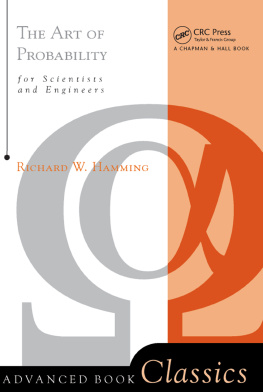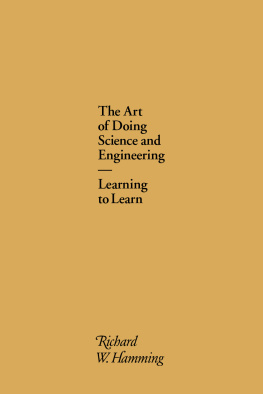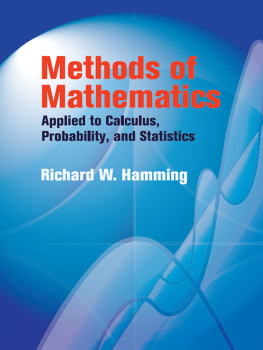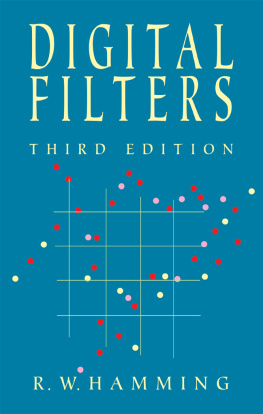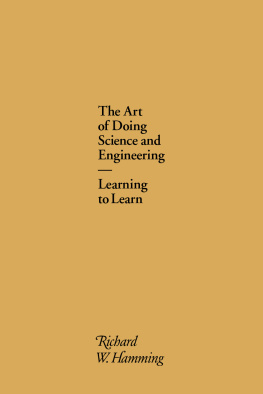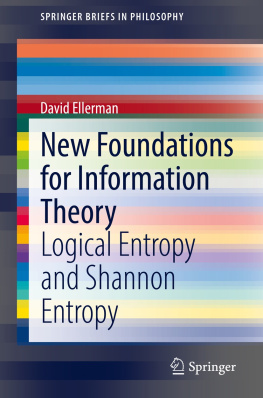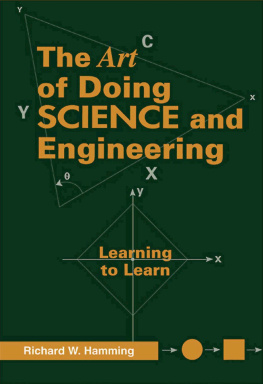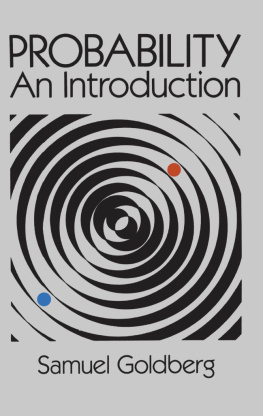Contents
Page List

THE ART OF PROBABILITY
FOR SCIENTISTS AND ENGINEERS
The Art of Probability
FOR SCIENTISTS AND ENGINEERS
Richard W. Hamming
U. S. Naval Postgraduate School

Text Design: Peter Vacek
Cover Design: Iva Frank
First published 1991 by Westview Press
Published 2018 by CRC Press
Taylor & Francis Group
6000 Broken Sound Parkway NW, Suite 300
Boca Raton, FL 33487-2742
CRC Press is an imprint of the Taylor & Francis Group, an informa business
Copyright 1991 by Taylor & Francis Group LLC
No claim to original U.S. Government works
This book contains information obtained from authentic and highly regarded sources. Reason-able efforts have been made to publish reliable data and information, but the author and publisher cannot assume responsibility for the validity of all materials or the consequences of their use. The authors and publishers have attempted to trace the copyright holders of all material reproduced in this publication and apologize to copyright holders if permission to publish in this form has not been obtained. If any copyright material has not been acknowledged please write and let us know so we may rectify in any future reprint.
Except as permitted under U.S. Copyright Law, no part of this book may be reprinted, reproduced, transmitted, or utilized in any form by any electronic, mechanical, or other means, now known or hereafter invented, including photocopying, microfilming, and recording, or in any information storage or retrieval system, without written permission from the publishers.
For permission to photocopy or use material electronically from this work, please access www.copyright.com (http://www.copyright.com/) or contact the Copyright Clearance Center, Inc. (CCC), 222 Rosewood Drive, Danvers, MA 01923, 978-750-8400. CCC is a not-for-profit organiza-tion that provides licenses and registration for a variety of users. For organizations that have been granted a photocopy license by the CCC, a separate system of payment has been arranged.
Trademark Notice: Product or corporate names may be trademarks or registered trademarks, and are used only for identification and explanation without intent to infringe.
Visit the Taylor & Francis Web site at
http://www.taylorandfrancis.com
and the CRC Press Web site at
http://www.crcpress.com
Library of Congress Cataloging-in-Publication Data
Hamming, R. W. (Richard Wesley), 1915
The art of probability-for scientists and engineers/Richard W. Hamming.
p. cm.
Includes index. |
1. Probabilities. | I. Title. |
QA273.H3544 | 1991 |
519.2-dc20 | 90-42240 |
ISBN 0-201-51058-8 (H) | CIP |
ISBN 0-201-40686-1 (P) |
This book was typeset using the TEX typesetting language on IBM Compatible computer
ISBN 13: 978-0-201-40686-3 (pbk)
If we want to start new things rather than trying to elaborate and improve old ones, then we cannot escape reflecting on our basic conceptions.
Hans Primas [P, ]
Every field of knowledge has its subject matter and its methods, along with a style for handling them. The field of Probability has a great deal of the Art component in itnot only is the subject matter rather different from that of other fields, but at present the techniques are not well organized into systematic methods. As a result each problem has to be looked at in the right way to make it easy to solve. Thus in probability theory there is a great deal of art in setting up the model, in solving the problem, and in applying the results back to the real world actions that will follow. It is necessary to include some of this art in any textbook that tries to prepare the reader to use probability in the real world of science and engineering rather than merely admire it as an abstract discipline and a branch of mathematics.
It is widely agreed that art is best taught through concrete examples. Especially in teaching probability it is necessary to work many problems. Since the answers are already known the purpose of the Examples and Exercises cannot be to get the answer but to illustrate the methods and style of thinking. Hence the Examples in the text should be studied for the methods and style as well as for the results; also they often have educational value. Thus in solving the Exercises style should be considered as part of their purpose.
It is not enough to merely give solutions to problems in probability. If the art is to be communicated to the reader then the initial approachwhich is so vital in this fieldmust be carefully discussed. From where, for example, do the initial probabilities come? Only in this way can the reader learn this artand most mathematically oriented text book simply ignore the source of the probabilities!
What is probability? I asked myself this question many years ago, and found that various authors gave different answers. I found that there were several main schools of thought with many variations. First, there were the frequentists who believe that probability is the limiting ratio of the successes divided by the total number of trials (each time repeating essentially the same situation). Since I have a scientific-engineering background, this approach, when examined in detail, seemed to me to be non-operational and furthermore excluded important and interesting situations.
Second, there are those who think that there is a probability to be attached to a single, unique event without regard to repetitions. Via the law of large numbers they deduce the frequency approach as something that is likely, but not sure.
Third, I found, for example, that the highly respected probabilist di Finetti [dF, p. x] wrote at the opening of his two volume treatise,
Probability Does Not Exist.
Fourth, I found that mathematicians tend to simply postulate a Borel family of sets with suitable properties (often called a -algebra or a Borel field) for the sample space of events and assign a measure over the field which is the corresponding probability. But the main problems in using probability theory are the choice of the sample space of events and the assigment of probability to the events! Some highly respected authors like Feller [F, p. x] and Kac [K, ] were opposed to this measure theoretic mathematical approach to probability; both loudly proclaimed that probability is not a branch of measure theory, yet both in their turn seemed to me to adopt a formal mathematical approach, as if probability were merely a branch of mathematics and not an independent field.
Fifth, I also found that there is a large assortment of personal probabilists, the most prominent being the Bayesians, at least in volume of noise. Just what the various kinds of Bayesians are proclaiming is not always clear to me, and at least one said that while nothing new and testable is produced still it is the proper way to think about probability.
Finally, there were some authors who were very subjective about probability, seeming to say that each person had their own probabilities and there need be little relationship between their beliefs; possibly true in some situations but hardly scientific.
When I looked at the early history of probability I found the seeds of most of these views; apparently very little has been settled in all these years.

